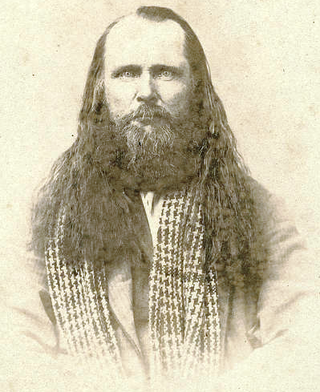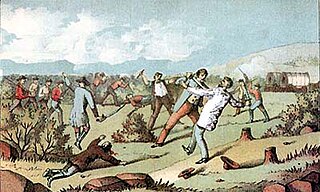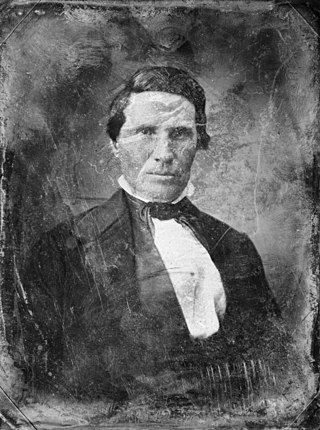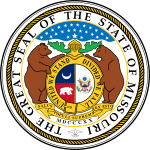
Caldwell County is a county located in Missouri, United States. As of the 2020 census, the county's population was 8,815. It is part of the Kansas City metropolitan area. Its county seat is Kingston. The county was organized December 29, 1836, and named by Alexander Doniphan to honor John Caldwell, who participated in George Rogers Clark's Native American Campaign of 1786 and was the second Lieutenant Governor of Kentucky.

Lilburn Williams Boggs was the sixth Governor of Missouri, from 1836 to 1840. He is now most widely remembered for his interactions with Joseph Smith and Porter Rockwell, and Missouri Executive Order 44, known by Mormons as the "Extermination Order", issued in response to the ongoing conflict between church members and other settlers of Missouri. Boggs was also a key player in the Honey War of 1837.

Orrin Porter Rockwell was a figure of the Wild West period of American history. A lawman in the Utah Territory, he was nicknamed Old Port, The Destroying Angel of Mormondom and Modern-day Samson.

The 1838 Mormon War, also known as the Missouri Mormon War, was a conflict between Mormons and their neighbors in Missouri. Early in the third decade of the nineteenth century, members of the Church of Christ began to migrate into Jackson County, Missouri. Their religious and political beliefs and practices differed from those of their Missourian neighbors. This and their social and economic cohesiveness began to trigger tensions and episodes of vigilante violence.

Missouri Executive Order 44 was a state executive order issued by Missouri Governor Lilburn Boggs on October 27, 1838, in response to the Battle of Crooked River. The clash had been triggered when a state militia unit from Ray County seized several Mormon hostages from Caldwell County, and the subsequent attempt by the Mormons to rescue them.

Alexander William Doniphan was a 19th-century American attorney, soldier and politician from Missouri who is best known today as the man who prevented the summary execution of Joseph Smith, founder of the Church of Jesus Christ of Latter Day Saints, at the close of the 1838 Mormon War in that state. He also achieved renown as a leader of American troops during the Mexican–American War, as the author of a legal code that still forms the basis of New Mexico's Bill of Rights, and as a successful defense attorney in the Missouri towns of Liberty, Richmond and Independence.
William Henry Ashley was an American miner, land speculator, manufacturer, territorial militia general, politician, frontiersman, fur trader, entrepreneur and hunter. Ashley was best known for being the co-owner with Andrew Henry of the highly-successful Rocky Mountain Fur Incorporated, otherwise known as "Ashley's Hundred" for the famous mountain men working for the firm from 1822 to 1834.

Daniel Dunklin was the fifth Governor of Missouri, serving from 1832 to 1836. He also served as the state's third Lieutenant Governor. Dunklin is considered the "Father of Public Schools" in Missouri. Dunklin was also the father-in-law of Missouri Lieutenant Governor Franklin Cannon. Dunklin County, in the Missouri bootheel, is named so in his honor.
Ashley is a census-designated place in Pike County, Missouri, United States. It is located on Route 161, approximately six miles south of Bowling Green.
Franklin Cannon was an American politician from the state of Missouri. A Democrat, he served as the state's 5th Lieutenant Governor. Cannon was the son-in-law of Missouri's 3rd Governor, Daniel Dunklin.

William Barclay Napton (1808–1883) was an American politician and jurist from the state of Missouri. A Democrat, Napton served as the state's 4th Attorney General, and multiple terms on the Missouri Supreme Court.

The 1824 Missouri gubernatorial election was held on August 2, 1824, Frederick Bates defeated Lt. Gov William Henry Ashley. Both candidates were members of the Democratic-Republican Party. The death of Frederick Bates in August 1825, meant that the next election for governor of Missouri would be held little more than a year after this election.

An attempted assassination of Lilburn Boggs occurred on May 6, 1842, when an unknown assailant fired buckshot into the home of Lilburn Boggs, striking the former Missouri Governor. Boggs was shot through a window as he read a newspaper in his study and was hit in four places: two balls were lodged in his skull, a third lodged in his neck, and a fourth entered his throat and was swallowed. Boggs was severely injured. Several doctors—Boggs's brother among them—pronounced his injuries fatal, and at least one newspaper ran an obituary. To general surprise, Boggs not only survived, but his condition gradually improved.
Boggs is a surname. Notable people with the surname include:

Tulocay Cemetery is a cemetery located in Napa, California originally established in 1859 following Governor pro tem Manuel Jimeno to Cayetano Juárez's 1853 donation of approximately 48 acres (0.2 km2) of land to the people of Napa.
Panthea Grant Boone Boggs was the First Lady of Missouri from 1836 until 1840. She was also a granddaughter of American pioneer Daniel Boone. She was married to Lilburn Boggs who served as the sixth Governor of Missouri from 1836 to 1840. They spent the first 23 years of their marriage living in Jackson County, Missouri. After Boggs served as governor, they moved to California in 1846 where they planned to retire, but where the former governor served as alcalde, local postmaster, and in the California state assembly.
Henry Carroll Boggs was a farmer, businessman and banker who was prominent in Lake County, California in the late 19th century. His name was given to Boggs Mountain and Boggs Lake.
Joseph A. Boggs was an American Army officer. Ranked Lieutenant, he fought in the American Revolutionary War.

The 1832 Missouri lieutenant gubernatorial election was held on 6 August 1832 in order to elect the lieutenant governor of Missouri. Democratic nominee and incumbent member of the Missouri Senate Lilburn Boggs defeated National Republican nominee James McClelland.











